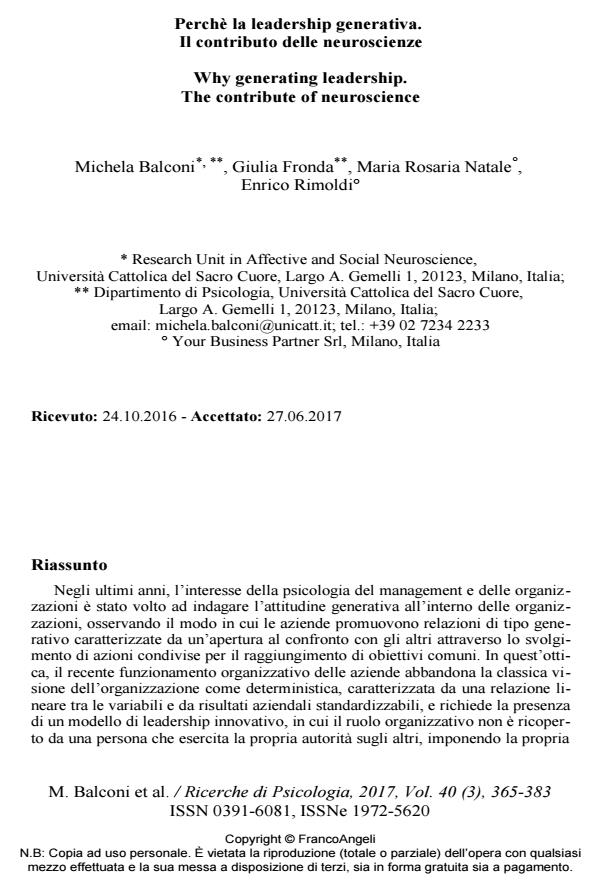Why generating leadership. The contribute of neuroscience
Journal title RICERCHE DI PSICOLOGIA
Author/s Michela Balconi, Giulia Fronda, Maria Rosaria Natale, Enrico Rimoldi
Publishing Year 2017 Issue 2017/3
Language Italian Pages 19 P. 365-383 File size 220 KB
DOI 10.3280/RIP2017-003007
DOI is like a bar code for intellectual property: to have more infomation
click here
Below, you can see the article first page
If you want to buy this article in PDF format, you can do it, following the instructions to buy download credits

FrancoAngeli is member of Publishers International Linking Association, Inc (PILA), a not-for-profit association which run the CrossRef service enabling links to and from online scholarly content.
During the last few years, the interest of management and organization psychology has been characterized by the investigation on generative attitudes within organizations; observing how companies promote generative relationships, which are characterized by an openness towards the confrontation with the others, meant as a co-execution of actions in order to achieve common goals. In this perspective, the latest organizational operation of the companies abandons the classical vision of the organization as deterministic, therefore characterized by a linear relationship between variables with standardized corporate results, and requires the presence of an innovative leadership model in which the organizational role is not covered by a person who exercises his authority over others by imposing his own individual vision. Actually, the new leadership model, unlike classical theories on the leader’s figure, promotes and facilitates the evolution of interaction behavior by creating conditions for the self-organization of the individuals and by creating contexts that promote interconnections and mutual exchanges. The new position of "generative" leaders values each component of the work team through a focus on "care", improving relational effectiveness and promoting the decision-making autonomy of their cooperators. Due to this new perspective in corporate contexts, the interest in neuroscience has focused on the study of components that can favor a well-being environment, focusing on leadership skills and relational dynamics.
Keywords: Generative leadership, generative organizational systems, social neuroscience, neuroleadership, decision-making autonomy, interdependence.
- The Neurological Correlates of Leadership and their Relevance to Education 5.0 Navreet Kaur, in SDMIMD Journal of Management /2025 pp.85
DOI: 10.18311/sdmimd/2025/48906 - Face-to-face vs. remote digital settings in job assessment interviews: A multilevel hyperscanning protocol for the investigation of interpersonal attunement Michela Balconi, Giulia Fronda, Federico Cassioli, Davide Crivelli, Humaira Nisar, in PLOS ONE /2022 pp.e0263668
DOI: 10.1371/journal.pone.0263668 - Drawing the business management perspective of the Disruptive Based on brain coaching skills and design thinking Ehsan chitsaz, marziyeh bakhtiari, in Quarterly Journal of Skill Training /2023 pp.157
DOI: 10.61186/irtvto.11.43.157
Michela Balconi, Giulia Fronda, Maria Rosaria Natale, Enrico Rimoldi, Perchè la leadership generativa. Il contributo delle neuroscienze in "RICERCHE DI PSICOLOGIA " 3/2017, pp 365-383, DOI: 10.3280/RIP2017-003007